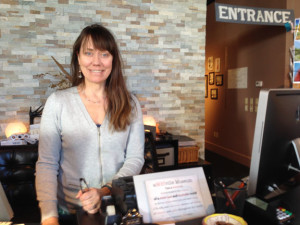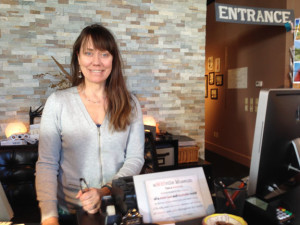Upon entering the aSHEville Museum, the space is vibrant and colorful. Visitors first encounter the gift shop, where an assortment of fair trade items that support human rights organizations and local women artists beckon them. Sparkling earrings and silky scarves are artfully placed among other beautiful items, creating an environment for guests to appreciate women’s art as soon as they come through the door.
During my visit to the museum, I caught a glimpse of its daily activity. As I waited for another museum employee to take over working the front desk, I watched Swann greet museum visitors. The melodic tone of her voice eased customers in as they perused this new world they had entered. I watched as a sense of calm washed over them and they took in their surroundings.
This is exactly what Swann envisioned for the museum—a place for visitors to get out of the headspace of their daily lives. “One of my goals with this was to get people out of their heads and down into their bodies and into the felt sense because that’s where things land… I really felt it was important to create an environment where people could settle down into their somatic experience and feel something, and feel what they feel, and feel safe to do so,” she told me.
Ever since Swann was a little girl, she has had a passion for storytelling and women’s rights. The aSHEville Museum (pronounced a-she-ville) presented her with the perfect opportunity to combine these interests with her experience as an entrepreneur. “I wanted to create a place where we could take people on a journey through history, through a bit of humor, and then maybe into a bit of heartache, and then back out into inspiration, hope, and a call to action.”
Swann created the museum with her daughter, Gems Ouizad, two years ago. The museum now highlights the stories of women from all walks of life, all over the world. Though it hasn’t been around for long, the museum has already featured a multitude of exhibits.
Community collaboration has become key to the museum. On July 5 th , an exhibit called “Bought and Sold” opened, highlighting the stories of human trafficking victims with photographs by Kate Chernush. Mamie Adams of Asheville’s >>Our VOICE , a local sexual assault prevention and intervention organization, helped create the exhibit and spoke at the opening. The exhibit is interactive, allowing visitors to scan the QRL code on their phones and hear the stories of the survivors featured in the images on view. It also highlights Truckers against Trafficking, an organization that trains truckers to identify signs of human trafficking and report them.
This is only one of many exhibits involving collaboration among organizations; the Center for Diversity Education at UNC Asheville, the Asheville YWCA, Dining for Women, and many more have been involved in creating displays for or featured in the aSHEville Museum. But you don’t have to be part of an organization to be featured in the Museum—you don’t even have to be an adult! One project Swann is particularly excited about is “Girls Leading the Way”, an exhibit about young girls from all over the world doing amazing things. In fact, for anyone reading this: if you know any extraordinary young girls, please reach out to the museum email and let her know! They may be featured in the exhibit.
Not only are visitors able to engage with women’s rights through the exhibits, but they can make a difference in women’s lives simply by making purchases in the museum gift shop. “We represent over 50 local regional women and families now. We have a lot of fair trade as well from all over the world,” Swann says. Many of the products featured in the shop are not only fair trade, but are made by victims of trafficking and benefit human rights organizations. “It feels wonderful to be able to offer these products to people where they can make a difference with their sales.”
Visitors appreciate the opportunity to take part in ethical consumption, too. I watched as a couple and their two children walked around the gift shop upon entering the museum. The mother held up an item and explained to her one of the children, who looked to be five or six, what fair trade meant. “These are the kind of places we want to shop,” she told him. “The things here are made fairly, and then paid a fair price for them.”
Indeed, the aSHEville Museum is a place of learning, inspiration, and actions for people of all ages and all backgrounds. “I have always desired to make a difference and to give back. I have always been interested in becoming a story teller and have not, and it finally came to me that this is my way of becoming a story teller—to create a place to talk about the accomplishments and the challenges faced by women in girls across history and across the world,” Swann told me. In the aSHEville Museum, Swann has crafted just that.
Admission for the aSHEville Museum is on a sliding scale of $5-$15, and free for children under the age of ten. For organizations that serve disadvantaged communities, schools, and youth groups, admission is free, and can be applied for by emailing >>info@ashevillemuseum.com one week before visiting. Please visit >>ashevillemuseum.com for more information.


There are no comments
Add yours